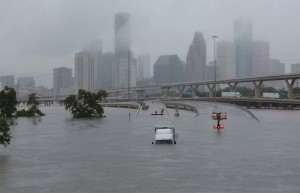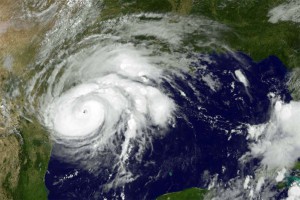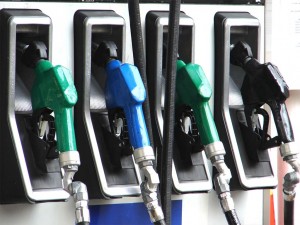While Hurricane Harvey remains fixed in place over the Gulf Coast of Texas, motorists across the U.S. are likely to begin feeling the storm’s impact this week. And higher prices could be around for a while, experts warn, as it is expected to take weeks, even months for the region’s refineries to repair from the damage caused by a storm of such historic proportions.
Almost of the total U.S. refinery capacity is based along the Gulf Coast, and while not all of that has been affected by the storm, Exxon Mobil’s Baytown refinery, 30 miles east of Houston, was taken off-line over the weekend, with no firm date for restarting operations. That one refinery produces as much as 13% of the U.S. fuel supply, or 2.3 million barrels a day.
“There is going to be no gasoline being produced for a bit of time,” said W. D. Williams of AAA Auto Club, the service warning that depending on the part of the country – as well as the duration and ultimate severity of the hurricane – gas prices could jump as much as 30 cents a gallon.
(Automakers expect to see sales rise for August after months of decline. Click Here for the story.)
Gas prices were already on the rise after hitting a national low of around $2.22 for a gallon of regular unleaded in July 12, noted tracking service GasBuddy.com. A week before the storm hit, that had climbed to around $2.32, And even before the storm’s impact could be felt prices had begun surging, with the national figure at $2.38 on Monday morning.
Complicating matters, crude inventories had already been slipping, according to the Energy Information Administration. So were gasoline inventories, which were off by 2.8 million barrels, or 1.2%, from year-earlier levels. With refinery operations in the rest of the country averaging about 95% — the Midwest pushing near 99% — it will be a challenge, observers warn, for the capacity lost along the Gulf to be made up elsewhere.
“Larger refinery outages would increase…long crude and short product impacts,” Goldman Sachs analysts wrote in a report estimating it could be weeks before operations in the areas hit by Hurricane Harvey are back up to full capacity.
It’s not just the loss of refinery capacity that could impact fuel prices. The Interior Department reported Sunday that oil production in the Gulf of Mexico was down 22%, or 379,000 barrels a day, because of the storm.
Major storms, especially those that sweep through the Gulf, frequently impact pump prices. That was true for Hurricanes Katrina, Rita and Ike, which saw motorists paying prices as much as 80 cents a gallon more, at peak, according to data tracked by PIRA Energy. But such spikes tended to be short-lived, as refineries quickly came back online, while facilities in other parts of the country helped pick up the slack.
But Harvey, which came ashore as a Category 4 hurricane, is proving to be a storm of what meteorologists are calling “historic proportions.” In some areas along the Texas coast, as much as 50 inches of rain are expected before the storm subsides. But the situation is being complicated by fears that what remains of Harvey – now downgraded to a Tropical Storm – may move back out over the Gulf, pick up new energy and strike land once again as a hurricane.
That could dump substantially more water on already flooded areas, create more wind damage and further complicate repairs to refineries like the Exon Mobil facility in Baytown.
(As waters dry, beware of buying flood-damaged cars. Click Here for helpful tips.)
Barring a second strike, Tom Kloza, of the Oil Price Information Service predicted Harvey’s impact could be less than that of the Hurricane Katrina, the superstorm that devastated New Orleans 12 years ago. He expects refineries in the Corpus Christi area to be back in operation by mid-week.
But the timing of the storm could complicate matters for motorists, even if Gulf refineries do recover quickly. The coming weekend brings the Labor Day holiday and a big burst of travel that strains fuel supplies even in normal times. That could lead to even bigger increases at the pump.
(Will your next car be made of wood, even sugar beets? Click Here for more.)



